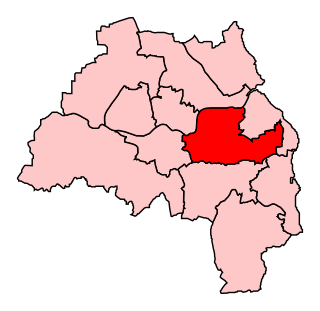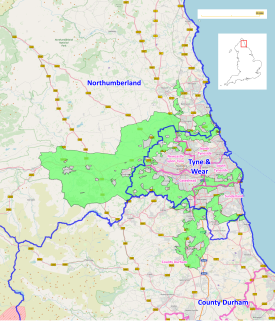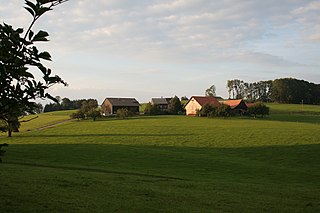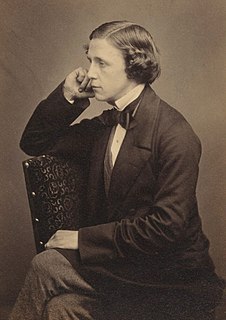
Tyne and Wear ( ) is a metropolitan county in the North East region of England around the mouths of the rivers Tyne and Wear. It came into existence in 1974 after the passage of the Local Government Act 1972. It consists of the five metropolitan boroughs of South Tyneside, North Tyneside, City of Newcastle upon Tyne, Gateshead and City of Sunderland. It is bounded on the east by the North Sea, and has borders with Northumberland to the north and County Durham to the south.

South Shields is a coastal town in the North East of England at the mouth of the River Tyne, about 3.7 miles (6.0 km) downstream from Newcastle upon Tyne. Historically in County Durham, the town has a population of 75,337, the third largest in Tyneside after Newcastle and Gateshead. It is part of the metropolitan borough of South Tyneside which includes the towns of Jarrow and Hebburn. South Shields is represented in Parliament by Labour MP Emma Lewell-Buck. The demonym of a person from South Shields is either a Geordie or a Sand dancer.

Newbottle is a village in North East England, lying between Durham and Sunderland, one and a half miles north of Houghton-le-Spring. The village occupies an elevated position and is accessed from three sides up a steep bank.

Marsden is located on the outskirts of the seaside town South Shields, North East England, located on the North Sea coast.

Souter Lighthouse is a lighthouse located in the village of Marsden in South Shields, Tyne & Wear, England. Souter was the first lighthouse in the world to be actually designed and built specifically to use alternating electric current, the most advanced lighthouse technology of its day.

Jarrow is a constituency ESE of and adjoining Newcastle upon Tyne. The constituency has been represented in the House of Commons by Stephen Hepburn of the Labour Party since 1997.

The Boldons are a group of three small villages in the north east of England - East Boldon, West Boldon and Boldon Colliery - north of Sunderland, east of Newcastle and south of South Shields and Jarrow. They have a population of 13,271.

Cleadon is a suburban village in South Tyneside, North East England in the county of Tyne and Wear, and the historic County Durham. In 2001 the population of Cleadon was 4,795, increasing for the South Tyneside ward of Cleadon and Boldon at the 2011 Census to 8,457. Nearby villages or population centres include East Boldon, Whitburn, and Jarrow. The village is around 5 miles from the city of Sunderland and 10 miles from the city of Newcastle.

South Shields railway station was the main railway station for South Shields, in Tyne and Wear, North-East England. The station was located on Mile End Road in the town centre. The station was opened by the NER in 1879 as the terminus of their newly extended Newcastle and South Shields Railway branch from Pelaw via Hebburn and had two platforms and an ornate overall roof.
The first settlers of the South Shields area were the Brigantes, although there is no evidence they built a settlement at South Shields. The Romans built a fort there to help supply Hadrian's Wall. Many ruins still exist today. The fort was abandoned as the empire declined.

Tyne and Wear is the metropolitan area which includes all of Newcastle, and the city of Sunderland. However, Tyne and Wear is not an urban area as there are large green spaces between Newcastle and Sunderland. There is currently a large transportation system in Tyne and Wear, which includes a metro system, an exstensive bus network and an international airport. Nexus are the passenger transport executive responsible for transport in Tyne and Wear with its headquarters in Newcastle, the primary transport hub of North East England.

The Tees–Wear derby is a football local derby contested between Middlesbrough F.C. and Sunderland A.F.C. who are separated by 2 rivers and 30 miles, in the North East of England. Historically this game would be considered the main regional rivalry for Middlesbrough, however it is viewed very much as secondary by those on Wearside, whose main derby match is the Tyne-Wear derby against Newcastle United. Broadly, Sunderland fans based in the City of Sunderland and further north towards Tyneside focus most of their attention on Newcastle. Middlesbrough are an afterthought in these areas primarily due to the increased distance from Teesside, and the lack of regular interaction with Teessiders. The rivalry of the Tees-Wear derby, however, is much more intense and evenly balanced in southern County Durham, where fans of both clubs live and work close together and interact regularly.
The North East Premier League is the top level of competition for recreational club cricket in the North East of England, serving the counties of Durham, Northumberland and Tyne and Wear. Since 2000 it has been a designated ECB Premier League.
Whitburn Colliery was a coal mine located about three miles south of South Shields, North East England, located on the North Sea coast.

The North East Combined Authority is a combined authority that covers part of the North East region of England. It was established by statutory instrument under the Local Democracy, Economic Development and Construction Act 2009 on 15 April 2014. It is a strategic authority with powers over transport, economic development and regeneration. At its first meeting on 15 April 2014, Simon Henig, Leader of Durham County Council, was elected as its chair. The functions, property, rights and liabilities of the former Tyne and Wear Integrated Transport Authority were inherited by the North East Combined Authority, forming an executive body within the new authority as the Tyne and Wear Passenger Transport Executive.

The North East Green Belt, also known as the Tyne & Wear Green Belt, is a non-statutory green belt environmental and planning policy that regulates the rural space in part of the North East region of England. It is centred on the county of Tyne and Wear, with areas of belt extending into Northumberland and County Durham. The belt functions to protect surrounding towns and villages outside the Tyneside/Newcastle-upon-Tyne and Wearside/Sunderland conurbations from further convergence. It is managed by local planning authorities on guidance from central government.






















